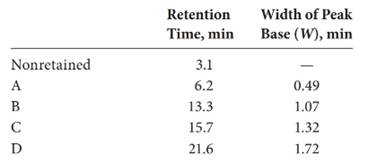
(a)
Interpretation:
The resolution for species B and C from the given data should be determined.
Concept introduction:
The resolution of the column is defined as the separation of two species of the column.
Answer to Problem 26.16QAP
The resolution is
Explanation of Solution
Given:

The expression of resolution of the column is:
Here, the retention time of species
Substitute
Thus, the resolution is
(b)
Interpretation:
The selectivity factor for species B and C from the given data should be determined.
Concept introduction:
The resolution of the column is defined as the separation of two species of the column.
Answer to Problem 26.16QAP
The selectivity factor is
Explanation of Solution
The expression of selectivity factor is:
Here, the non-retained retention time is
Substitute
Thus, the selectivity factor is
(c)
Interpretation:
The length of column necessary to separate B and C species with a resolution of
Concept introduction:
The resolution of the column is defined as the separation of two species of the column.
Answer to Problem 26.16QAP
The length of column necessary to separate the two species with a resolution of
Explanation of Solution
The expression of length of the column is:
Here, the number of plates needed to separate the two species is
The expression of relation of the resolution and number of plates is:
Here, the number of plates needed is
Substitute
Substitute
Thus, the length of column necessary to separate the two species with a resolution of
(d)
Interpretation:
The time required to separate B and C species on the column of part c should be determined.
Concept introduction:
The resolution of the column is defined as the separation of two species of the column.
Answer to Problem 26.16QAP
The time required to separate the two species on the column of part c is
Explanation of Solution
The expression of the relation of time required to separate the two species on the column is:
Here, the given resolution is
Substitute
Thus, the time required to separate the two species on the column of part c is
Want to see more full solutions like this?
Chapter 26 Solutions
Principles of Instrumental Analysis, 6th Edition
- Synthesize 2-Hydroxy-2-phenylacetonitrile from phenylmethanol using the necessary organic or inorganic reagents. Draw the structures of the compounds.arrow_forwardSynthesize N-Methylcyclohexylamine from cyclohexanol using the necessary organic or inorganic reagents. Draw the structures of the compounds.arrow_forwardSynthesize N-Methylcyclohexylamine from cyclohexanol using the necessary organic or inorganic reagents. Draw the structures of the compounds.arrow_forward
- If possible, please provide the formula of the compound 3,3-dimethylbut-2-enal.arrow_forwardSynthesize 1,4-dibromobenzene from acetanilide (N-phenylacetamide) using the necessary organic or inorganic reagents. Draw the structures of the compounds.arrow_forwardIndicate the products obtained by mixing (3-oxo-3-phenylpropyl)triphenylphosphonium bromide with sodium hydride.arrow_forward
- We mix N-ethyl-2-hexanamine with excess methyl iodide and followed by heating with aqueous Ag2O. Indicate the major products obtained.arrow_forwardIndicate the products obtained by mixing acetophenone with iodine and NaOH.arrow_forwardIndicate the products obtained by mixing 2-Propanone and ethyllithium and performing a subsequent acid hydrolysis.arrow_forward
- Indicate the products obtained if (E)-2-butenal and 3-oxo-butanenitrile are mixed with sodium ethoxide in ethanol.arrow_forwardQuestion 3 (4 points), Draw a full arrow-pushing mechanism for the following reaction Please draw all structures clearly. Note that this intramolecular cyclization is analogous to the mechanism for halohydrin formation. COH Br + HBr Brarrow_forwardIndicate the products obtained if 2,2-dimethylpropanal and acetaldehyde are mixed with sodium ethoxide in ethanol.arrow_forward
 Principles of Instrumental AnalysisChemistryISBN:9781305577213Author:Douglas A. Skoog, F. James Holler, Stanley R. CrouchPublisher:Cengage Learning
Principles of Instrumental AnalysisChemistryISBN:9781305577213Author:Douglas A. Skoog, F. James Holler, Stanley R. CrouchPublisher:Cengage Learning

